Feb 25, 2013
Local meet-ups connect like-minded Seattle travelers
Sports is the usual topic of conversation at the Pyramid Alehouse across from Seattle’s Safeco Field, but once a month, the talk was all about travel.
I recently joined nearly 100 others who showed up to share beers and conversation at the Seattle Adventure Travel Club’s monthly meet-up. Most of us were strangers, but after a round of quick introductions (“Hi, I’m Joe. I’d like to get to Siberia soon”), we were trading travel stories, exchanging email addresses and seeking advice with the same ease and enthusiasm that travelers connect with each other while on the road.
Whether you’re interested in just talking travel or looking for potential traveling partners, it’s never been easier to connect locally with like-minded people. For some ideas, see my Travel Wise column in this week's Seattle Times.
Feb 16, 2013
Carless in Seattle: Public transit can whisk you to where the locals go
 |
| The Seattle S.L.U.T. |
Catch a bus to the colorful neighborhood they call the "Center of the Universe" for a zombie walk or a lunch of Turkish pizza.
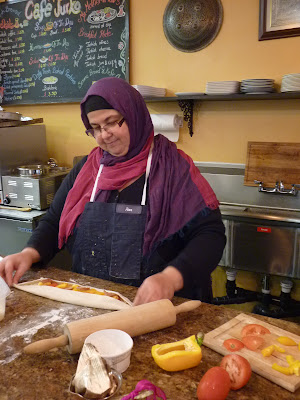 |
| Fremont's Cafe Turko |
 |
| The New Mohi Museum on Lake Union |
Board a ferry for a half-hour sail across Puget Sound to an urban island for wine tasting or coffee in the waterfront town of Winslow and a walk along a waterfront path.
Three suggestions in my recent story for the Portland Oregonian.
Ride the SLUT to South Lake Union
The Seattle Streetcar is how city officials like to refer to the 1.3 mile rail line running between downtown and the South Lake Union neighborhood developed by Microsoft co-founder Paul Allen's CQ Vulcan Real Estate company. Someone with a sense of humor came up with the idea of substituting the word "trolley'' for streetcar and the acronym stuck.
Replacing car dealerships and light industry around the lake is an urban park flanked by new restaurants, bars and shops aimed at the young and monied Amazonians working and living nearby.
Getting there: Streetcars run every 15 minutes, making 11 stops between Westlake and 5th Avenue downtown and Lake Union Park. Adult fare is $2.50.
Where to eat: Brick oven pretzels, craft beers, pizzas topped with sweet fennel sausage and roasted peppers...There's a reason Seattle chef Tom Douglas was named the James Beard Foundation's 2012 "Outstanding Restaurateur." With several restaurants, a bakery and a wine shop in the area, he's cornered the market on fun food and fine dining.
Where to shop: Surviving the changes so far is Antique Liquidators, in business at 503 Westlake Ave. N. for 39 years. Hidden among container loads of furniture shipped in from England are burlap coffee sacks, comic books and racks of vintage ties.
West Elm at 2201 Westlake Ave., Williams- Sonoma's version of a 21st century general store, stocks jars of cherry pie filling, fancy garden tools and glasses made from recycled wine bottles.
Don't miss: The newly-opened Museum of History & Industry at Lake Union Park near the end of the streetcar line. On display is the first commercial aircraft made by the Boeing Company in 1919 and a giant red neon R from the former Rainier Brewery.
 |
| Museum of History and Industry |
Click here for general tourism information
Take a ferry to Winslow
Sail away to Bainbridge Island, once a timber and shipbuilding center, now a bedroom community on the Kitsap Peninsula, 35 minutes from the Seattle waterfront.
Getting there: Walk on a Washington State ferry ($7.70 round-trip) at Seattle's Pier 52, then take a 10-minute stroll to the artsy hamlet of Winslow.
Where to eat: Seattle foodies make the trip regularly to dine at a quartet of destination restaurants. Joining Cafe Nola, the Four Swallows and Hitchcock is Restaurant Marche, a Northwest- inspired bistro run by longtime chef and island resident Greg Atkinson.
 |
| Pegasus Coffee |
 |
| Stone sculptures in Winslow |
Don't miss: A scoop of island-made dulce de leche ice cream from Argentine-owned Mora Iced Creamery, followed by a walk back to the ferry through Waterfront Park on Eagle Harbor.
Click here for tourism information.
Board a bus to Fremont
Instead of lighting a neighborhood Christmas tree each December, residents decorate a 7-ton statue of Vladimir Lenin salvaged from Slovakia. Other seasonal celebrations welcome Zombies, nude cyclists and chainsaw-wielding pumpkin carvers.
The funky neighborhood that the locals call "The Center of the Universe" blends bits of bygone hippie flavor with enough "what's new'' to compete with nearby Ballard, a Scandinavian neighborhood cultivating a late-night bar and restaurant scene.
 |
| The Center of the Universe |
Where to shop: Scoop up crafts and collectables at the year-around Fremont Sunday Market. Find martini glasses, fake furs, neon signs and Pyrex bakeware at the underground Fremont Vintage Mall, 3419 Fremont Ave. N. Burnt Sugar, 601 N. 35th St., sells a stylish mix of toys, boots, bags and shoes in a building topped with a Soviet-era rocket.
Where to eat: High-end experimental chefs mix it up with young entrepreneurs to produce new twists on Yakima River trout, English meat pies and old-school soft-serve.
Fremont resident Maria Hines chose Fremont for her third Seattle certified organic restaurant, the Sicilian bistro Agrodolce at 709 North 35th St. Hines joins Renee Erickson CQ (Boat Street cafe and Walrus and the Carpenter) who opened The Whale Wins CQ in the Fremont Collective, a converted warehouse at 3506 Stone Way N.
At the budget-friendly Cafe Turko, Sureyya Gokeri CQ rolls out dough for Turkish pizza in an open kitchen inside Istanbul Imports at 754 N. 34th St. The Flying Apron, 3510 Fremont Ave. N., turns out gluten-free cherry-cardamom muffins and vegan corn chowder served at communal tables.
Don't miss: The daily tours ($6) at the Theo organic chocolate factory. Watch beans being roasted on site, and sample bars spiked with coffee, chile or toasted coconut.
Click here for tourism information.
Feb 11, 2013
Beating high cost of rental cars in Hawaii
 |
Hawaii’s back.
Nearly 8 million visitors traveled to the islands last year, spending $13 billion. Airlines are adding seats. Travelers are again pouring in from the United States, Japan and Canada.
That means supplies of rental cars are stretched, leading to higher prices and, during some peak times, shortages.
“When car companies on the mainland need more cars, they just shift them from location to location,’’ says Ron Wigand, product manager for AAA Washington. “In Hawaii, it takes months to address that.’’
Adding to the problem was a longshore strike late last year that affected car shipments from distribution sites in Long Beach, Calif., and Los Angeles, said Clem Bason, president of the Hotwire Group.
Getting the best rate and the rental car you want in Hawaii will take some planning, so start early:
For some tips on how to save, follow these times outlined in my Travel Wise column in the Sunday Seattle Times:
-Book as far as you can in advance, especially if you travel over spring break, in summer or during the Christmas holidays.
“Come June 15, airlines will charge as much as they can, and car rentals are in perfect alignment with that through early August,’’ says Jeff Tucker of the Beat of Hawaii travel website
Most rental-car agencies don’t charge for changes or cancellations (some do for no-shows), meaning you can take advantage of better deals if you find one later. That doesn’t always apply to discounted prepaid rates, so check cancellation and change policies carefully.
Agencies base pricing on supply and demand, Wigand says. “As demand goes up and inventory goes down, prices go up. Rent now for Dec. 15, and you might pay $250 (per week). Wait until September, and it could be $450.’’
- Almost all major agencies have in-town locations, sometimes just a few miles from the airport. The cost of a taxi can be worth the savings, given Hawaii’s high airport surcharges, taxes and fees.
When I’m in Maui, I rent from Enterprise Rent-A-Car’s Hana Highway location, two miles from Kahului airport. A check on the Enterprise website in late January for a week’s economy-car rental in early March turned up a rate of $239 at the Hana location versus $551 at the airport.
Check operating hours at branch locations before you rent. Enterprise’s Hana branch, for example, closes on Sundays and at noon on Saturdays, and stays open only until 5 p.m. other days.
-Get quotes from local firms that negotiate wholesale rates with the major agencies.
Two with good reputations are Car Rental Hawaii and Discount Hawaii Car Rental.
-Check various third-party websites (airline sites, Orbitz, Expedia, etc.) against rates posted on the car-rental agencies’ own websites. If you haven’t booked early, call directly to see about last-minute cancellations. Ask about AAA or AARP discounts (10-20 percent), or try a travel agent.
- If you want an air/hotel package, find one that throws in a few days’ car rental at no extra cost. Pleasant Holidays has some available.
- Try Hotwire.com or Priceline.com. Both discount rental-car rates, but don’t reveal the name of the company until after you’ve booked and paid with a credit card. Bookings are nonrefundable.
Feb 9, 2013
Mexico City: Faces new and old
When we last visited Mexico City four years ago, Tom and I concentrated on three neighborhoods - La Condesa, St. Angel and Coyoacan - all areas with more of a village-like atmosphere than big-city feel. Spending time in any of these neighborhoods quickly counters the city's image of a hectic, smoggy and dangerous urban environment.
 |
| Coyoacan |
This time, at the end of an 11-day trip that took us by bus from Guadalajara to Zacatecas to Guanajuato and finally to Mexico City, we choose a bed and breakfast on the second floor of an office and apartment building in the heart of the Centro Historico, a few blocks away from the Zocolo and Alameda Park. The surprise: We again found ourselves in a neighborhood that was neither hectic, smoggy or dangerous.

David Marino and his wife, Eloise, were our hosts at Chillout Flat on Simon Bolivar Street in a building where David's mother once lived. The couple live in the building and have converted four rooms (two more on the way) into a cozy, urban B and B in the heart of the Centro Historico, a 34-block area, home to some of the city's most elaborate historic monuments, former palaces, stores and museums.
 |
| Hotel Cortes, from budget to boutique |
Things are changing in Mexico City. Investors are buying up run-down or vacant former mansions and renovating them into boutique hotels and chic restaurants. The government is pumping money into traffic improvements, beautifying the parks and putting a huge police presence on the streets. It's not an exaggeration to say that literally everywhere we turned there were either uniformed police and/or private security guards inside and outside restaurants, stores and along a network of pedestrianized streets that were lively late into the evening. Are there parts of Mexico City to avoid at night? Of course. But the Centro Historico is no longer one of them.
 |
| Vertical Garden |
 |
| Coffee at Que Bo |
 |
| Cafe de Tacuba |
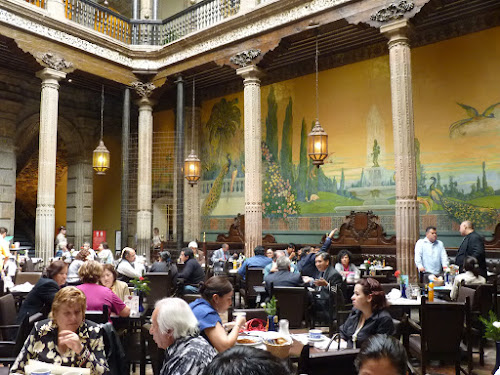 |
| Comida at Sanborns |
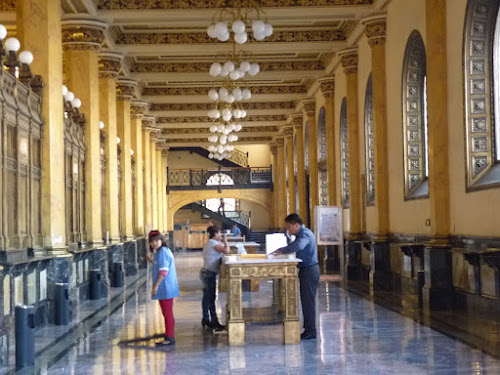 |
| Morning at the post office |
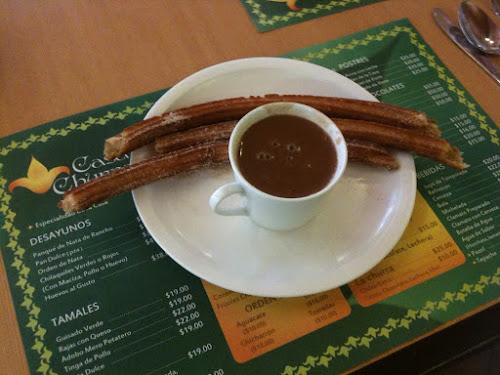 |
| Second breakfast |
Eloise served such ample breakfasts that we actually only indulged once, maybe twice in churros and chocolate, a traditional Spanish breakfast, served like this for around $4 at Casa Churras, a bright, new cafe on 16 de Septiembre.
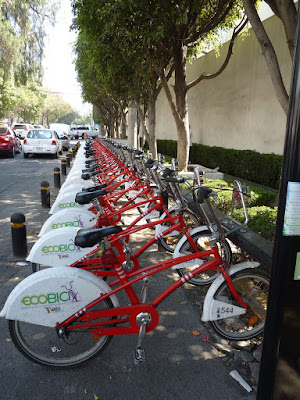 |
| Bikes in Polanco |
Also Carlos Slim's new "vanity'' museum in the wealthy neighborhood of Polanco. We took the subway, then walked a little more than a mile to see the new Museo Soumaya built by Slim to house his art collection.
 |
| Museo Soumaya |
- The location is surprising and not an area where tourists would normally go out of their way to visit. Next door is a Costco, a Sak's and General Motors offices. But the museum is free and it's worth taking the time to see, for the sleek architecture and the European and Mexican works displayed on six floors that spiral up to a top floor filled with sculptures by Dali and Rodin.
Mosaics by Diego Rivera stand out on the main floor along with a couple of Rodin sculptures displayed against stark, white backrounds.
Worth a revisit was Casa Azual, Frida Kahlo's house in Coyoacan to see the newly-opened display of her clothing, previously locked away and out of public view. Like the Surmaya, Casa Azul is not easy to reach via pubic transportation, but it's worth the effort to sample a bit of the Coyoacan neighborhood. We took the subway to the closest stop, then walked along a street called Francisco Sosa that leads to secret gardens and Spanish haciendas hidden behind the walls of buildings painted pink, blue and ocher.
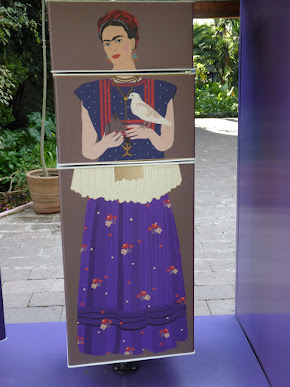 |
| Frida |
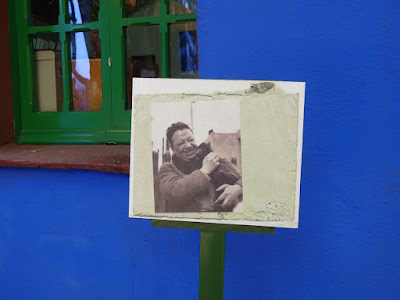 |
 |
| El Jarocho |
I guess it goes without saying, but seems important to say anyway that we felt very safe the whole time, as we expected we would since we weren't traveling in border towns or elsewhere where there have been problems.
Mexico's a big place, and when you're there, among hundreds of people out dancing in the squares, eating in the restaurants, shopping, enjoying music and museums, you get a completely different and more accurate impression of everyday life than you do by reading many of the news reports and U.S. government travel warnings.
Subscribe to:
Posts (Atom)




